The M4 Sherman tank was designed in late 1940 with infantry support in mind. However, by the time the Sherman reached the battlefield in late 1942, the technological demands of the rapidly escalating tank war showed that the Sherman was already falling behind in its abilities to combat German heavy tanks.
When Allied forces came ashore in Normandy during June of 1944, the Sherman was found lacking in firepower to defeat the Pz.Kpfw. V Panther tank (appearing in surprising numbers) and the Pz.Kpfw. VI Tiger I heavy tank. To make matters worse, tank crews lamented the Sherman’s inadequate armor protection against the German 75mm and 88mm high velocity anti-tank guns.
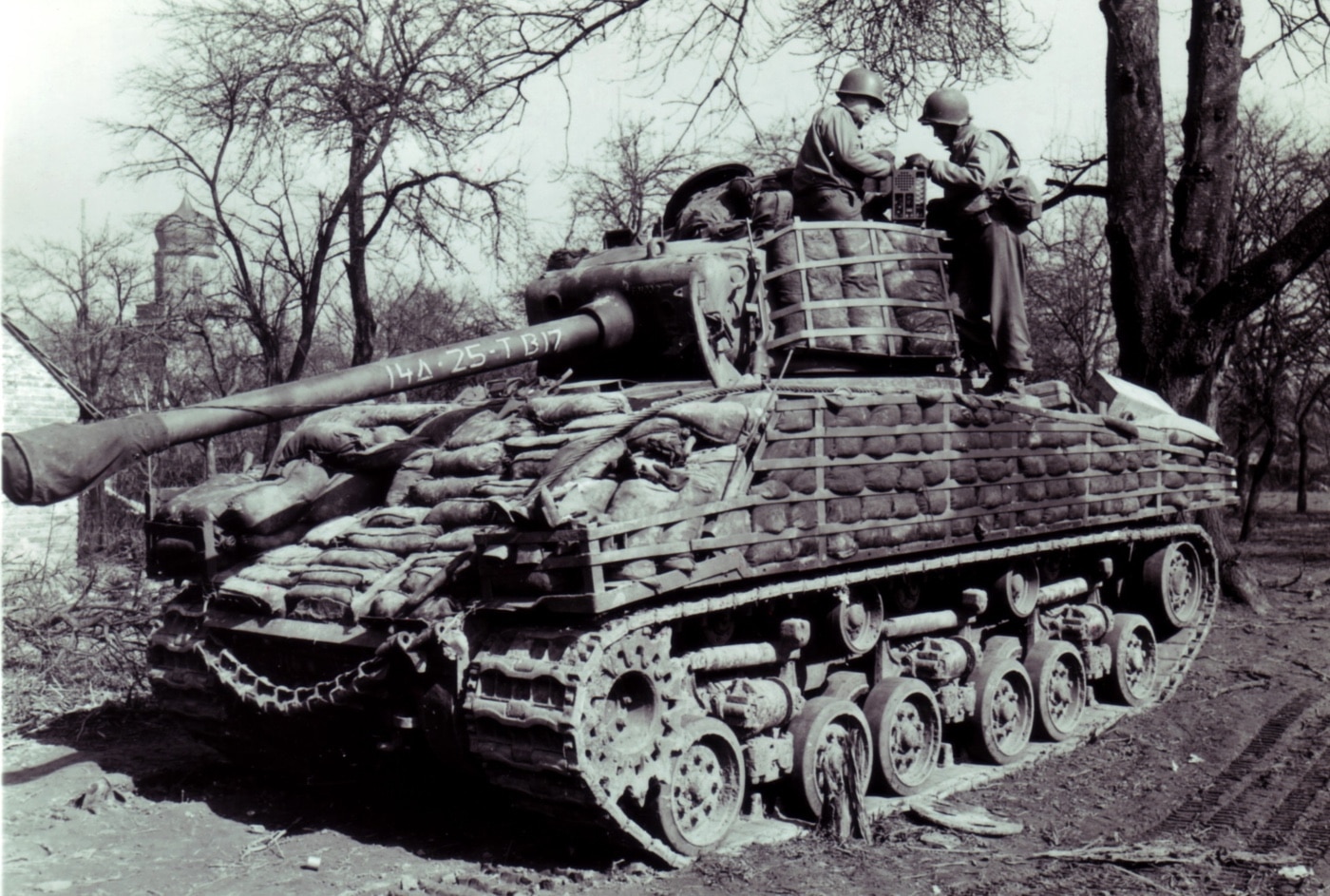
During the tank battles in the Normandy hedgerows, an additional threat to the Sherman appeared. Far less imposing than a Tiger tank or an 88mm gun, the new danger came in the form of infantry anti-tank weapons: the German Panzerschreck and disposable Panzerfaust. In close-range fighting in the bocage hedges or in urban areas, these recoilless, hollow-charge weapons began to take an alarming toll of Allied armored fighting vehicles (AFV), particularly the Sherman tanks.
Leveraging typical G.I. ingenuity, American tankers used field modifications to increase their protection against the enemy’s new, short-range anti-tank (AT) weapons.
Panzerfaust & Panzerschreck
The Panzerfaust or the Panzerschreck (8.8 cm RPzB 54) were not new to U.S. tankers, as both had been encountered during the campaign in Italy. However, they were not seen in great numbers, and American intelligence teams weren’t impressed enough to be particularly alarmed by them.
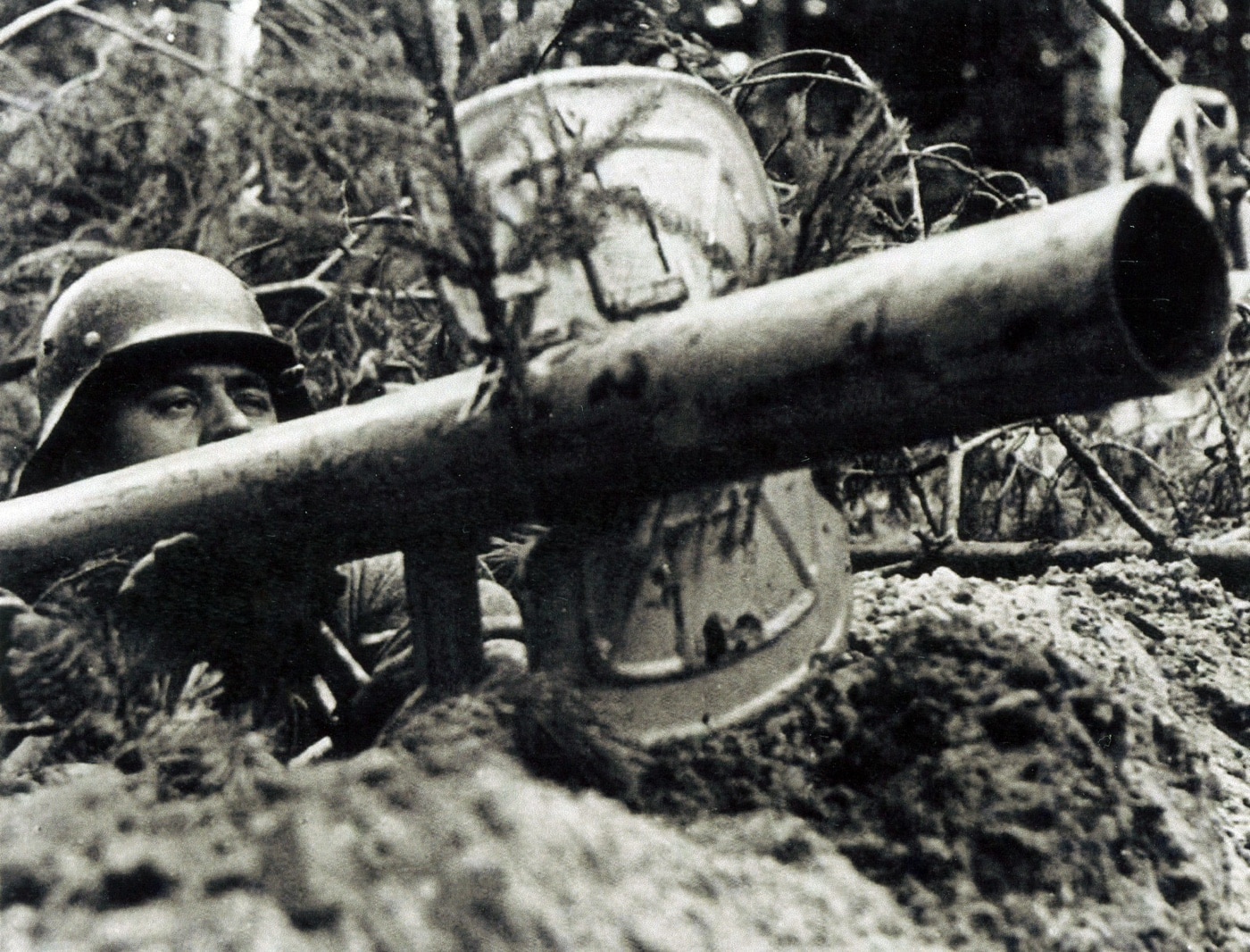
The Germans used captured examples of the U.S. 2.36-inch Bazooka as a starting point for their Panzerschreck — increasing the projectile size to 88mm and giving it much greater armor-penetrating power in its hollow-charge warhead. By mid-1944, the Panzerschreck had improved rockets, and had gained better sights to go along with a blast shield to protect the user. Its range was about 150 yards, and the deadly 7.2-pound RPzBGr 4322 rocket could penetrate 160mm of armor.
As for the “Faustpatrone” (later renamed “Panzerfaust”), it was developed as a very simple, disposable anti-tank grenade. The initial variant, the Panzerfaust “Klein” proved somewhat difficult to use, had a very short range (30 yards at best), and experienced a high dud rate with its warhead. However, when the Panzerfaust worked, it was very powerful.
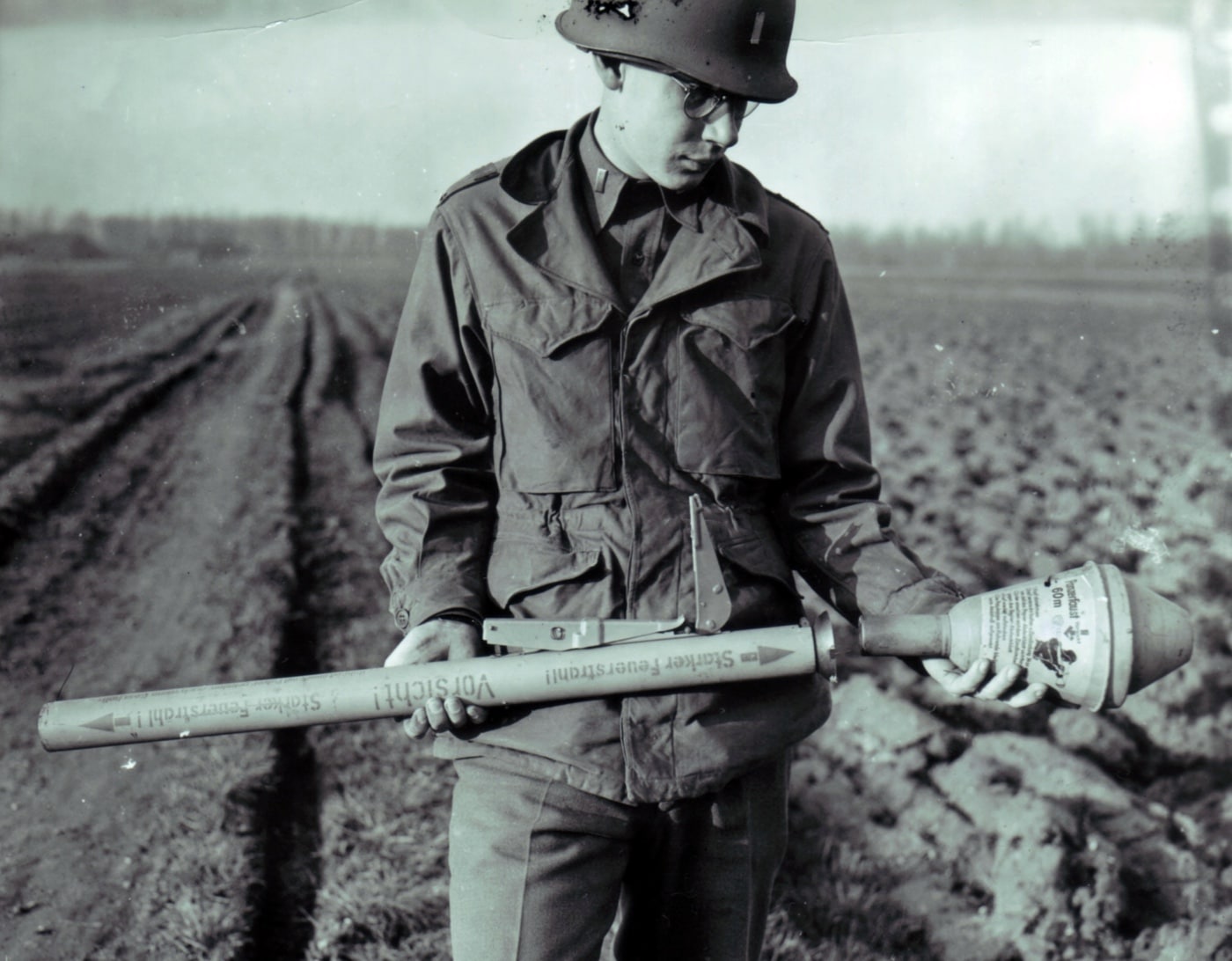
Revisions to the sights, warhead, and propellant charge soon followed, and the range doubled with the introduction of the Panzerfaust 60. Armor penetration was a whopping 200 millimeters, more than enough to piece any Allied tank. As each Panzerfaust cost no more than 25 Reichsmarks to build, the weapon became a particularly cost-effective tank killer.
Extra Protection
The protection on the M4 Sherman has often been criticized, but it needs to be remembered that the vehicle was a medium tank and was never designed to carry exceptionally thick armor. Ultimately, it is a credit to the Sherman’s strong engine and transmission that even as additional armor was added throughout the war, the M4 maintained much of its speed and serviceability.
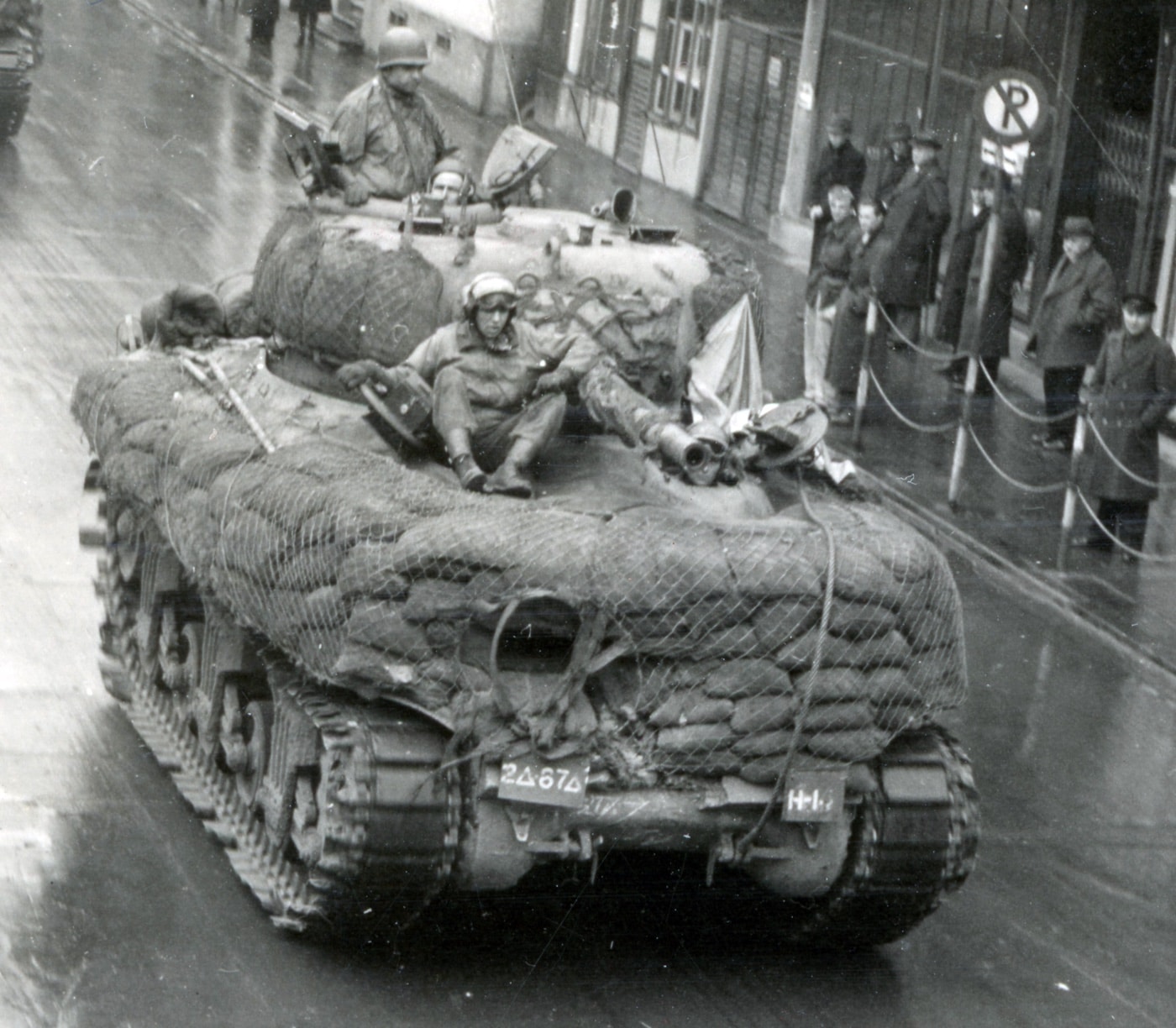
The Sherman’s turret was protected by 1” to 3” (25mm to 76mm) of armor. Some of the later M4 variants had a 3½” (89mm) mantlet. Regarding hull armor, by June of 1944, most Sherman tanks had a 2½” (63.5mm) glacis plate, sloped at 47 degrees, providing an effective thickness of nearly 3.7” (93mm) of protection. The transmission housing at the lower front was protected by up to 4.5” of armor. Many Shermans had 1” armor plate applied over the ammunition storage bins on their sponson sides in an effort to reduce ammo fires in this sensitive area. Unfortunately, the tall hull sides were only 1½” (38mm) thick, and this was a prime target area for German anti-tank gunners.
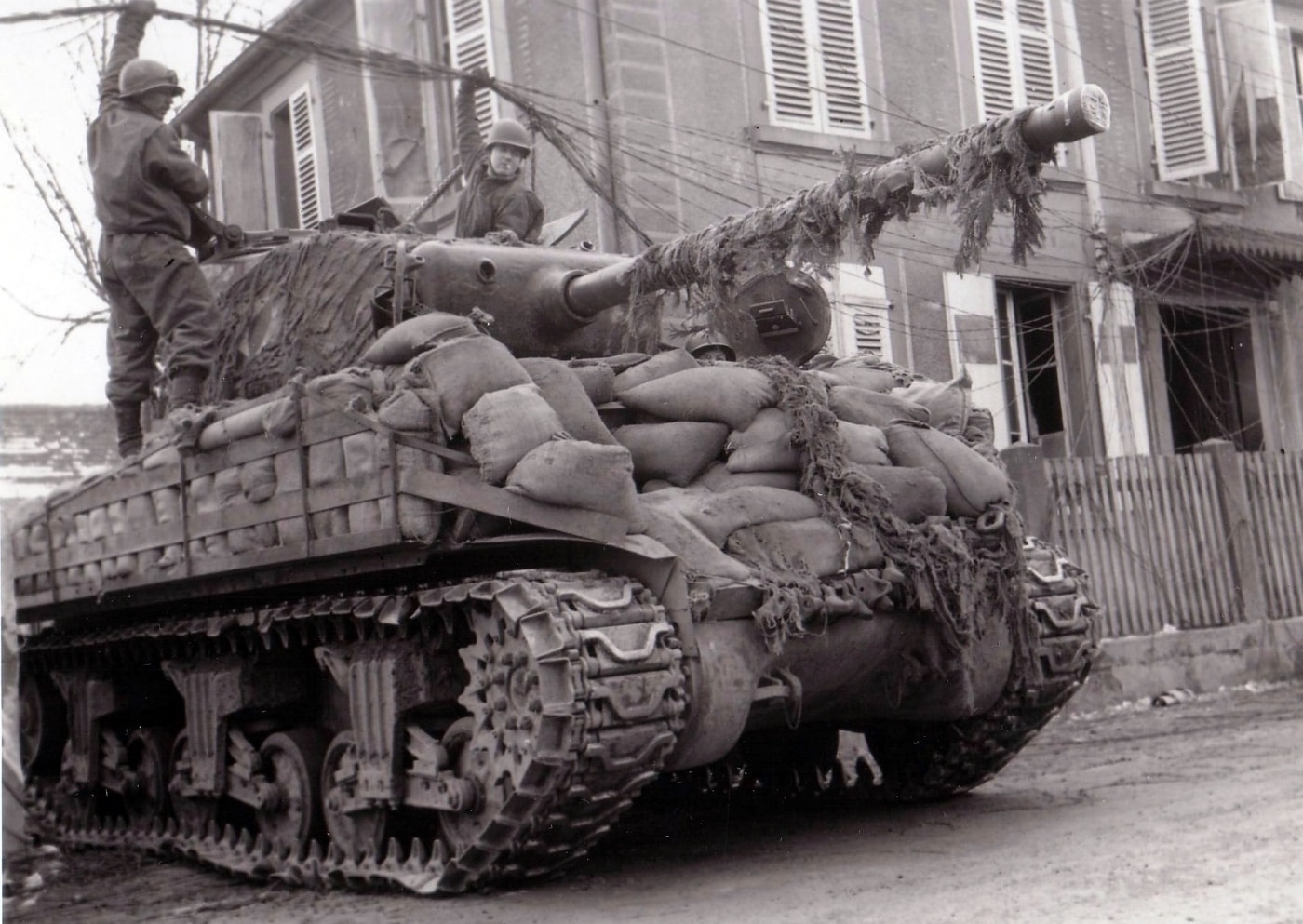
A wartime modification, the M4A3E2, upgraded the Sherman’s armor to U.S. heavy-tank standards. The variant (sometimes called the “Jumbo”), equipped with up to 5” of armor on the hull and 6” on the mantle, became a highly prized assault tank in the ETO. Unfortunately, there were only about 250 of these well-armored vehicles made.
From Sand to Steel
Beginning early in the war, tankers of all the combatant nations had positioned sandbags, extra track links, bogie wheels and even rocks on the front plate of their vehicles. These ad-hoc additions were marginally effective in providing extra protection, if only in the way of “something-is-better-than-nothing”.
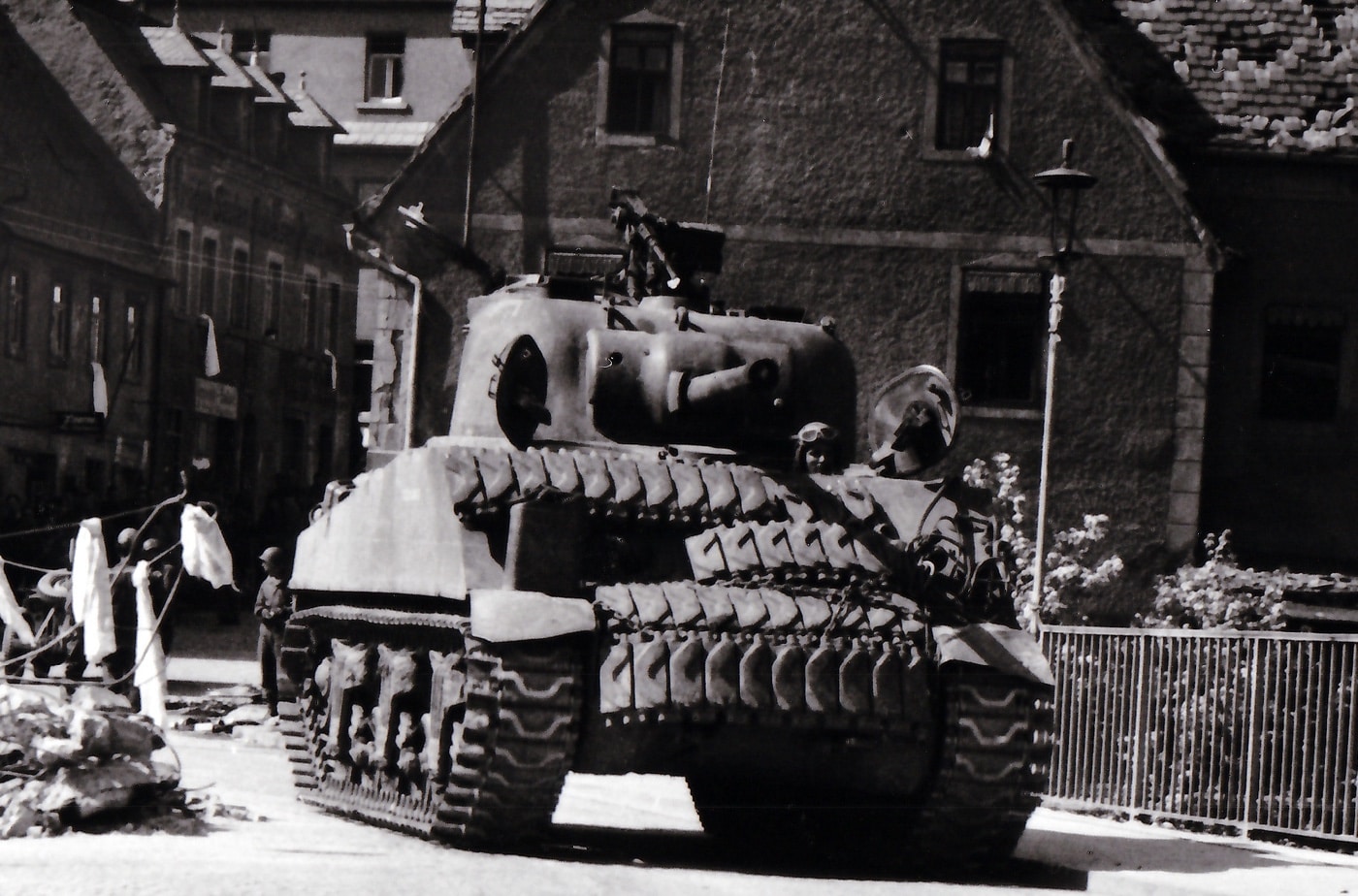
When facing smaller anti-tank guns of the early war period, sandbags and track links did provide a measure of protection against armor-piercing shot. By the summer of 1944, U.S. tankers were facing German 75mm and 88mm high-velocity guns — and sandbags would be of little value against them. However, their effectiveness against low-velocity, hollow-charge weapons was a different story.
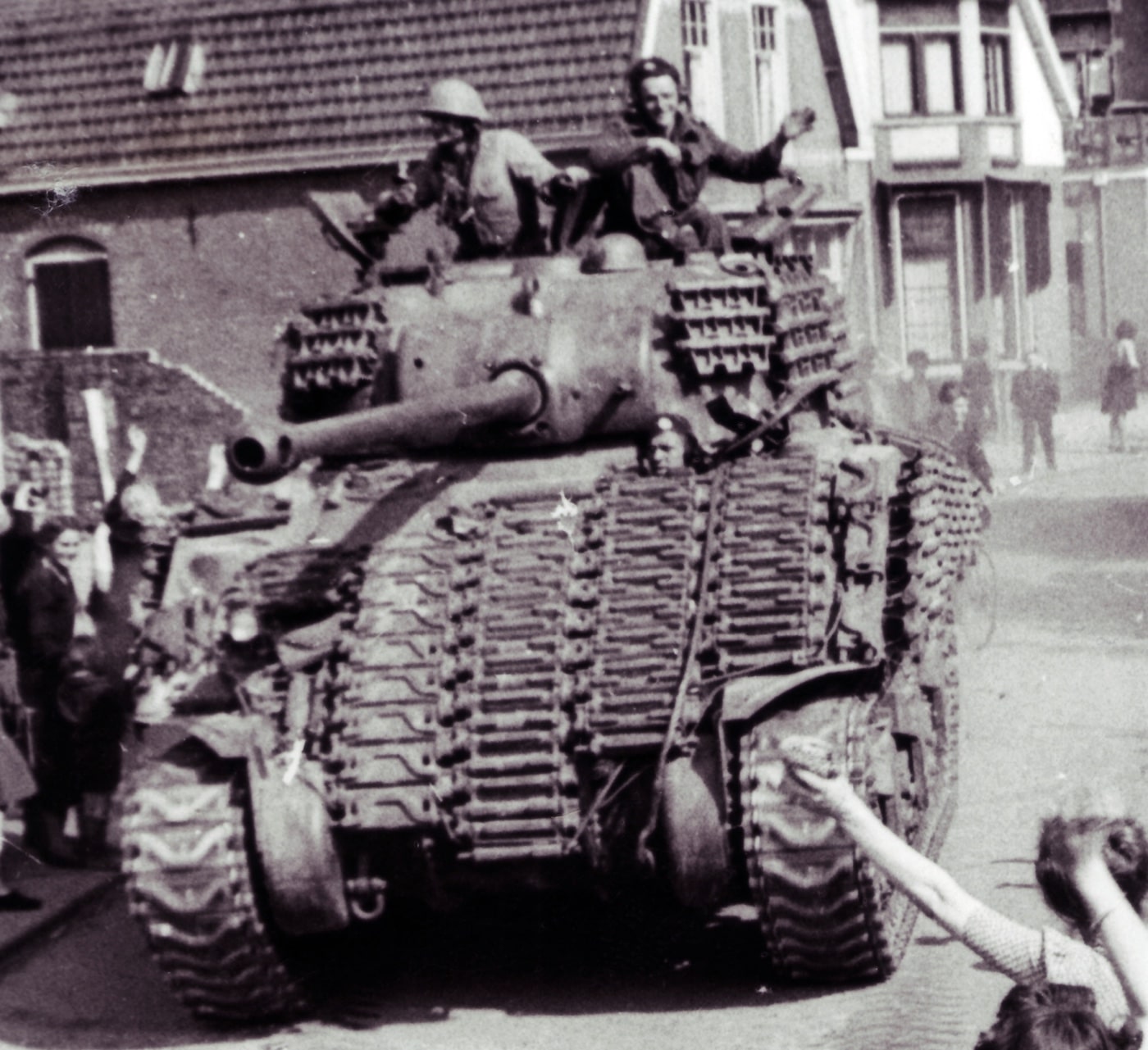
In September 1944, about 4% of U.S. tank losses were attributed to German Panzerfaust and Panzerschreck anti-tank launchers. By October, that number had risen to 12.5%. In November, it advanced to 14.5%.
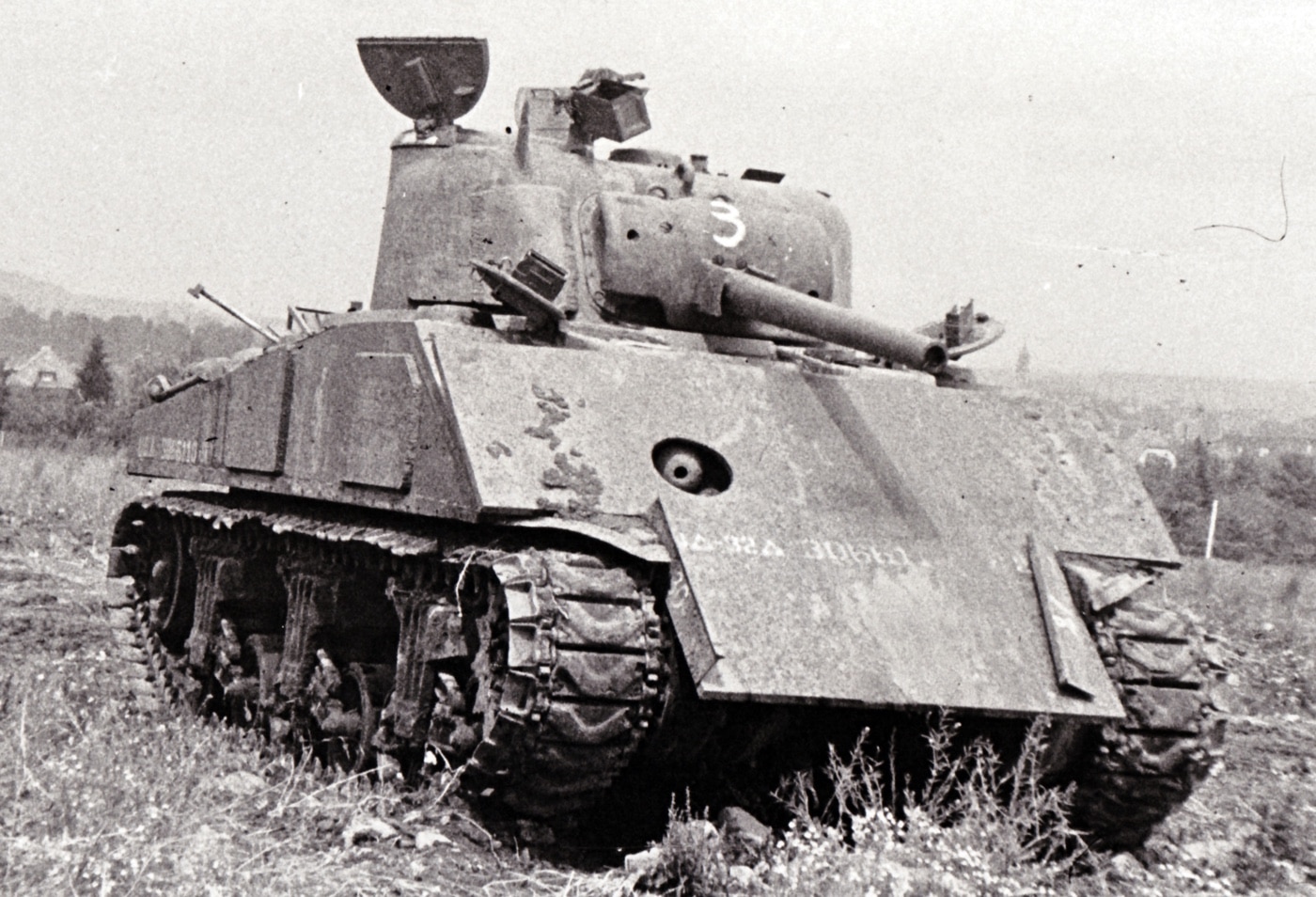
Reports from the earlier fighting in Normandy advised U.S. tankers to stay at least 30 yards from German-occupied hedgerows to maintain a safe distance from the Panzerfaust-equipped tank hunters. But this was not always possible, and the newer Panzerfaust 60 and 100 had increased range and armor penetration.
After the Battle of the Bulge, the Panzerfaust and Panzerschreck were increasingly the primary AT threat to the Sherman, as the M4s returned to infantry support duties as the G.I.s advanced into the Reich.
The U.S. Seventh Army was an early adopter of sandbag protection — with the 12th and (particularly) the 14th Armored Divisions equipping many of their vehicles with layers of sandbags.
Up to 170 sandbags were used on a single tank — two to four deep on the front plate, and two deep on the hull and turret sides. The extra weight for a Sherman, with the sandbags and the supporting metal framework to hold them combined, added up to about three tons.
Gen. George S. Patton Jr., in command of the Third Army, was an outspoken opponent of the practice. Patton’s primary objection was based on the weight of the sandbags, as he believed it slowed the tanks and wore out their engines and transmissions. In that respect, the general had a point, as speed was one of the Sherman tank’s greatest attributes.
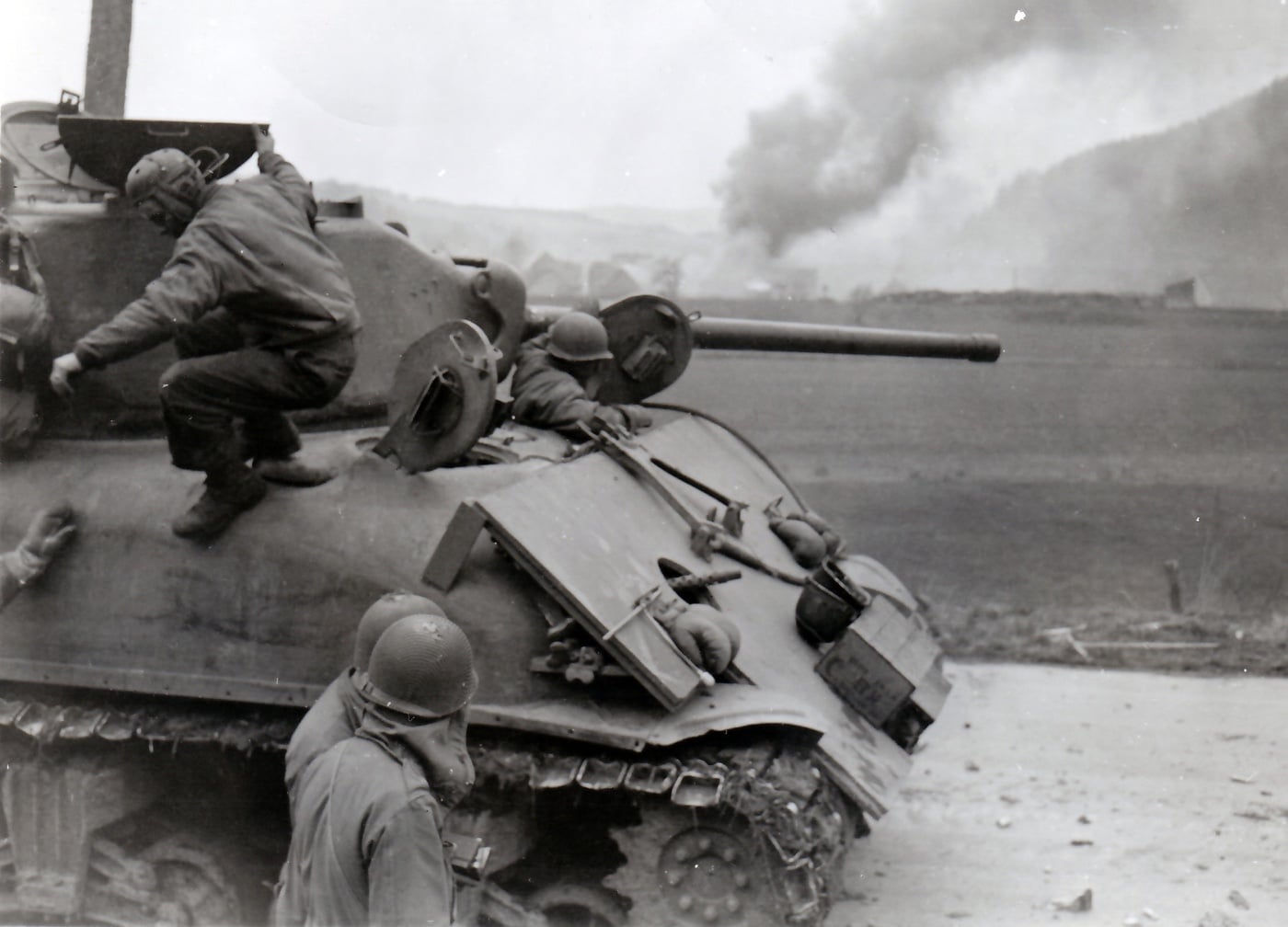
But Patton’s expectations of how quickly a U.S. armored division could advance were often outside of the reality imposed by combat conditions in Western Europe. While the Sherman could travel up to 26 mph on good roads and had a range of about 130 miles, it was rare when the M4 tanks moved at that rate.
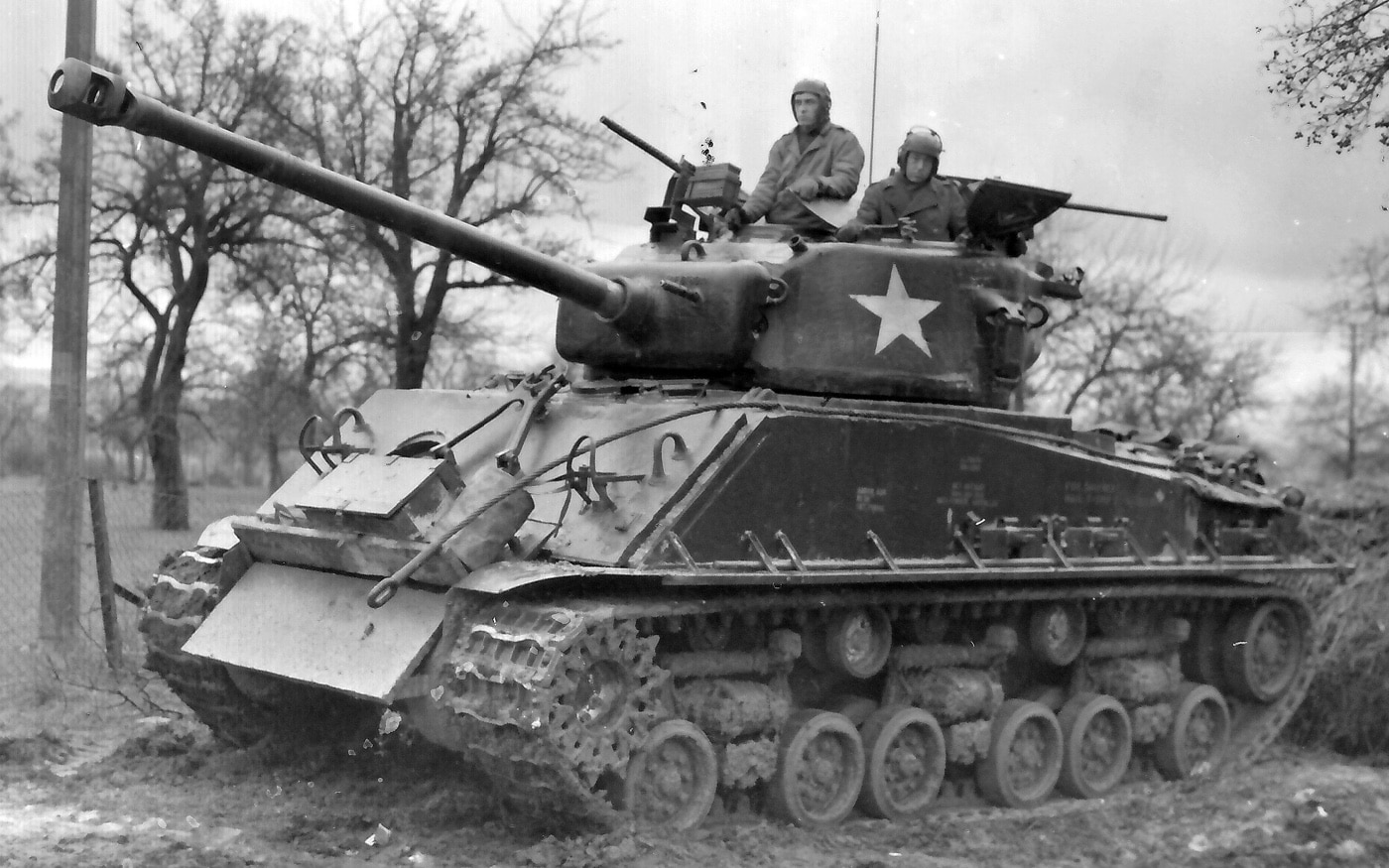
From an automotive perspective, the Sherman tank was excellent, and the mechanics within an American armored division were without equal. If there were a tank in the ETO that could accept the extra weight and still perform normally, it would be the Sherman. And from available evidence, the added protection never seriously degraded the M4’s automotive performance.
In late March 1945, a few U.S. tank units started to experiment with an application of concrete, sometimes up to 6” thick on the glacis plate. The concrete was added with varying degrees of sophistication — ranging from rough slabs to carefully poured and troweled cement meshed with steel within angled forms. The reinforced concrete was found to be more effective than the sandbags, particularly on the front plate.
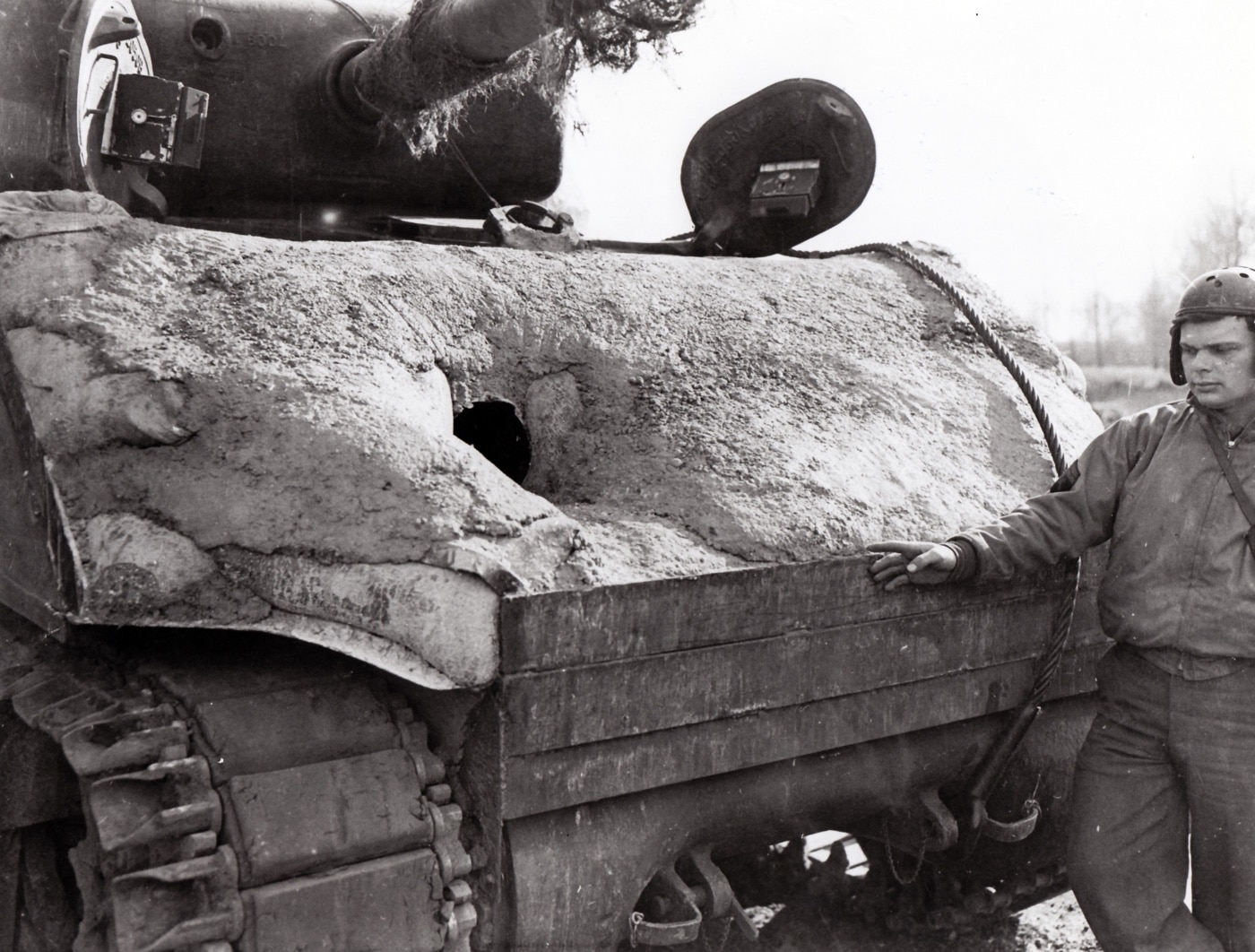
Sandbags and concrete had a mitigating effect on hollow-charge weapons — potentially directing the flame jet into an ineffective (or at least less-lethal) position, or with concrete, expending most of the flame-jet’s energy, even if it did penetrate the armor.
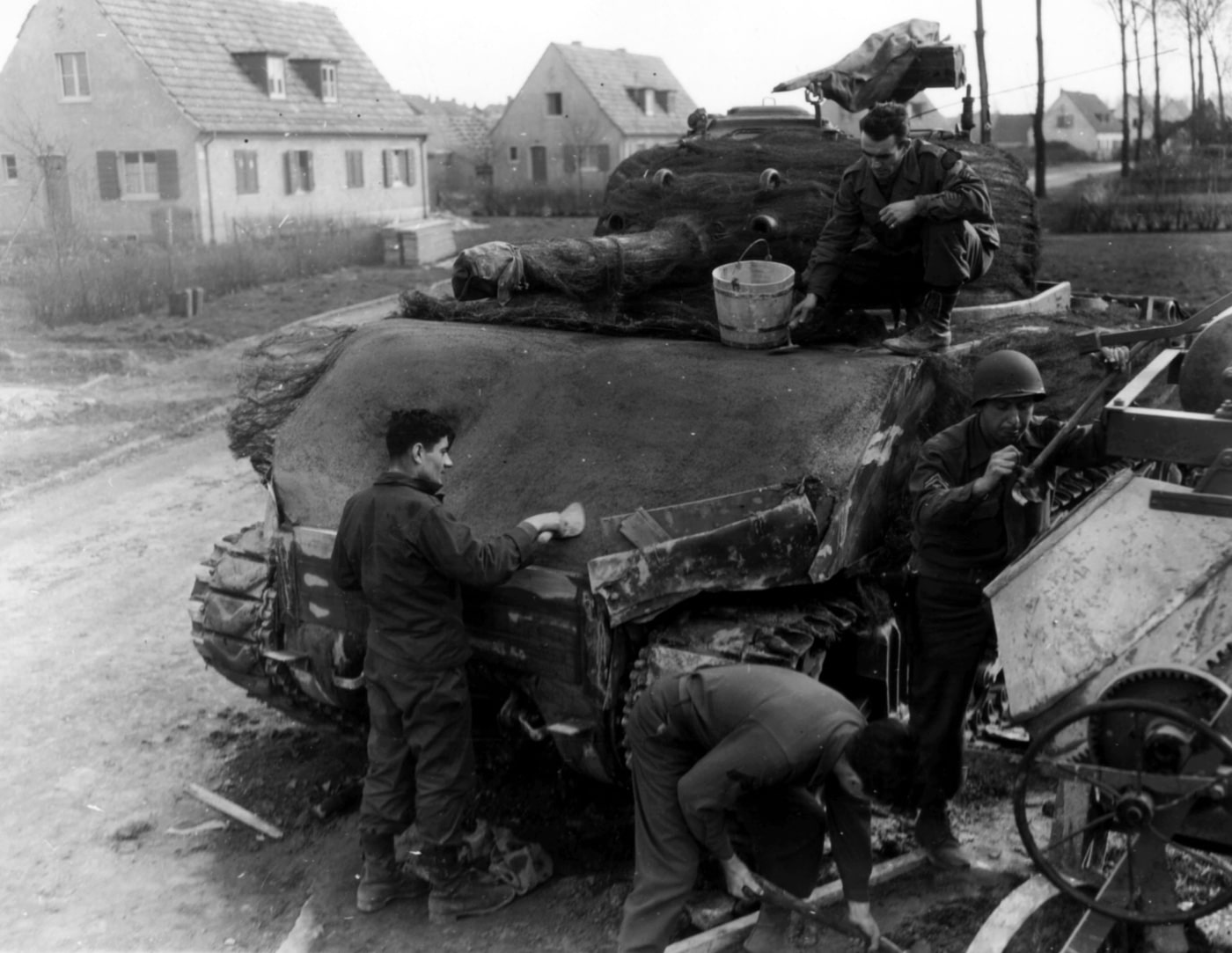
The 1st Armored Group’s tests with the Panzerfaust 60 against sandbagged Sherman tanks showed full penetration against the side, but not a complete penetration against the glacis plate. It is interesting to note that even the well-armored Sherman “Jumbo” assault tanks carried sandbags or concrete for additional protection.
A Natural Defense
Logs were the quickest, easiest, and cheapest method of adding protection. Timber was sometimes lashed to the side of a Sherman to offer a measure of protection for the hull against anti-tank rockets, and the occasional hand-placed magnetic mine. The logs offered an additional benefit as they could be used as “un-ditching rails” to help a tank get out of cloying mud. Occasionally, logs were used on the glacis plate to provide a framework for sandbags.
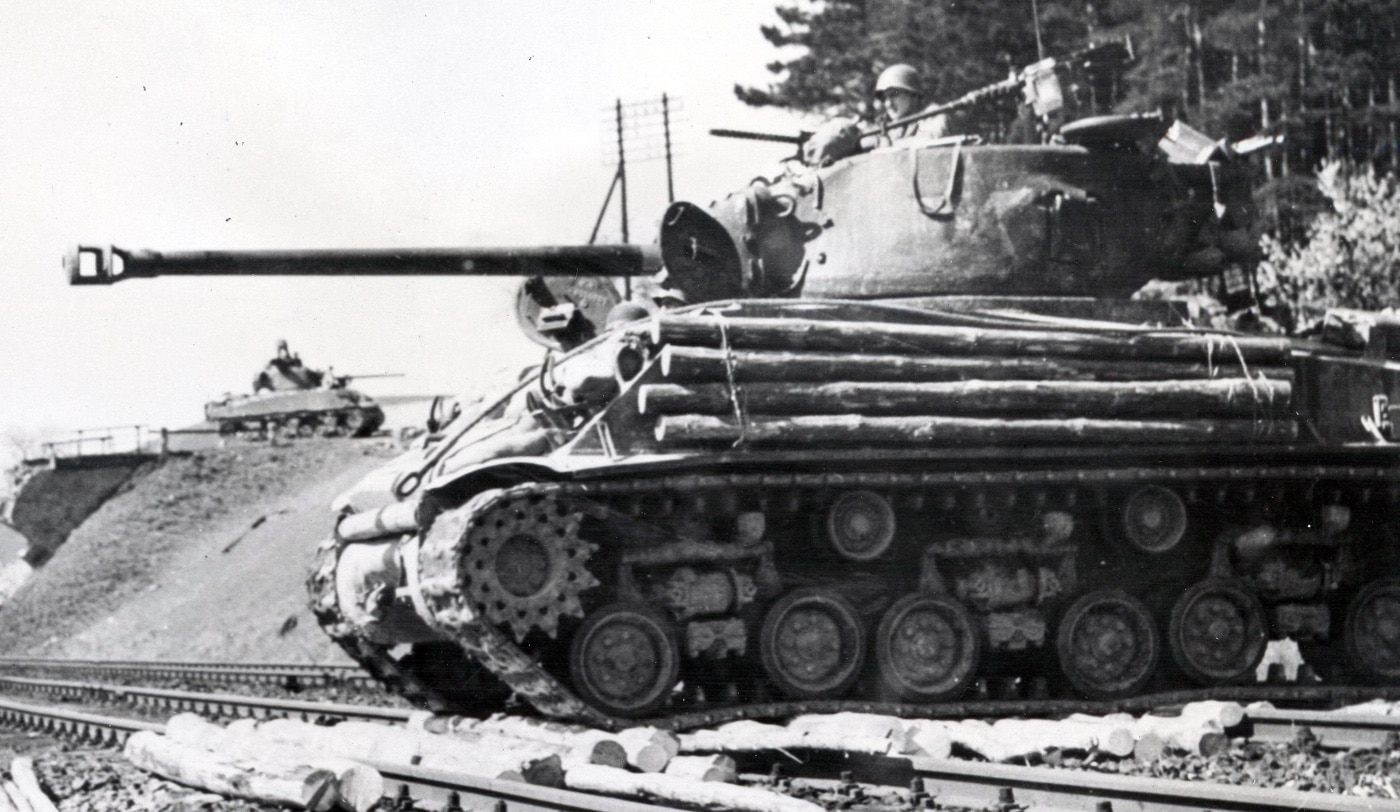
A late 1944 issue of the U.S. Army publication “Battle Experiences” had this advice for American tankers:
Log Protection for Medium Tanks: Mats made of four large logs the length of the tank afford bazooka protection when hung on the tank and can be used for road mats in muddy terrain and when crossing trenches. — C.O., Co. D, 67th Armored Regt.
Going Heavy
In early 1945, several U.S. armored divisions began to equip at least a portion of their tanks with added armor plate. Some of this additional armor was confiscated from captured German armament factories, while the rest was cannibalized from derelict M4s or captured German tanks. Reinforcing the Sherman with actual armor plate was the most sophisticated and effective of the field modifications, albeit the most time-consuming and the heaviest.
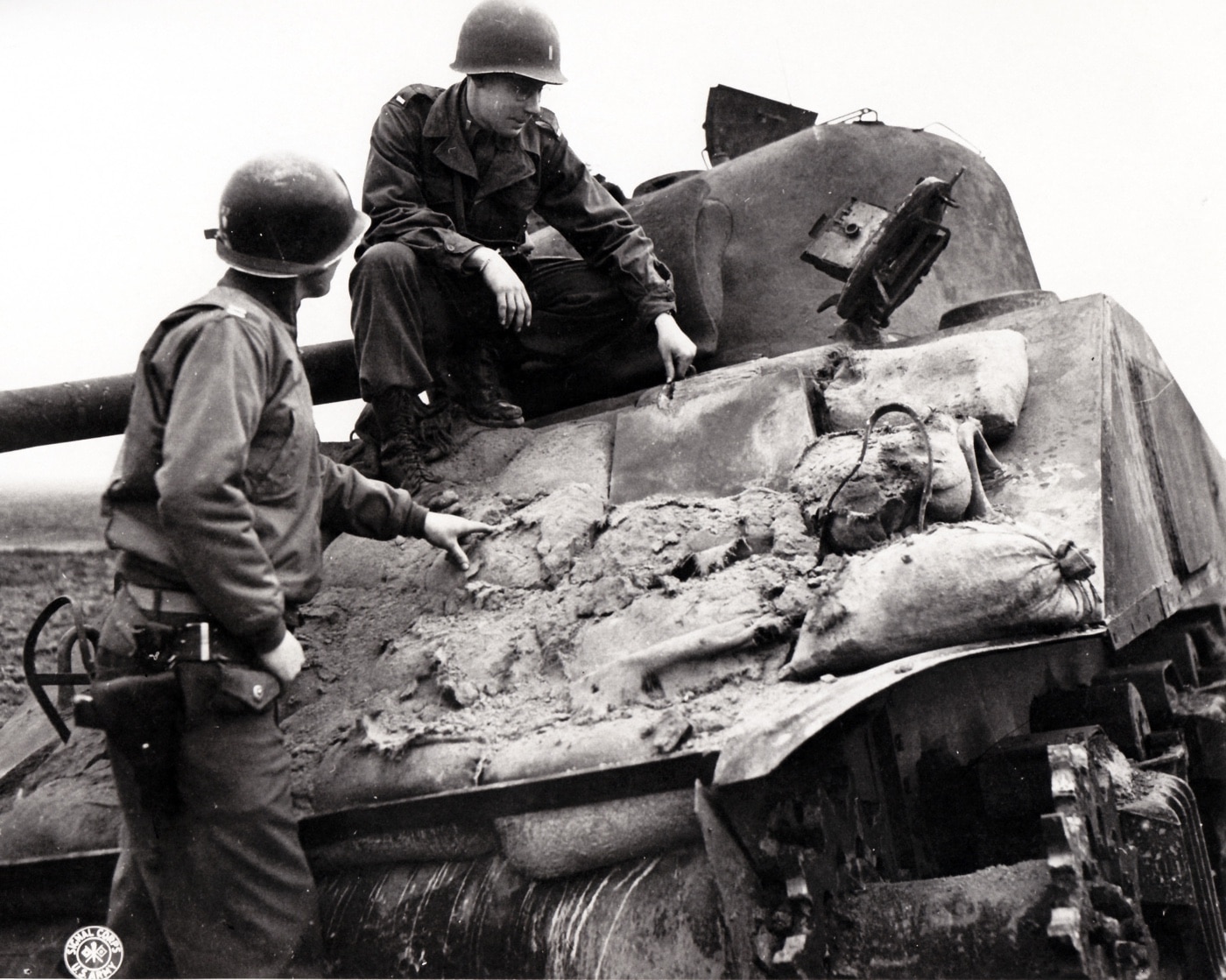
In a rare reversal, General Patton approved of this specific practice — but it was the least common.
A form of “composite armor” was created by the U.S. Ninth Army, where the Sherman was given a coating of steel track links welded to the hull and turret, and then a layer of sandbags was added over the links. A tight camouflage net covered the vehicle to keep the sandbags in place.
Experience Made a Big Difference
Additional protection for the Sherman was a definite necessity, but combat experience and teamwork expanded that protection beyond the passive nature of sandbags and concrete.
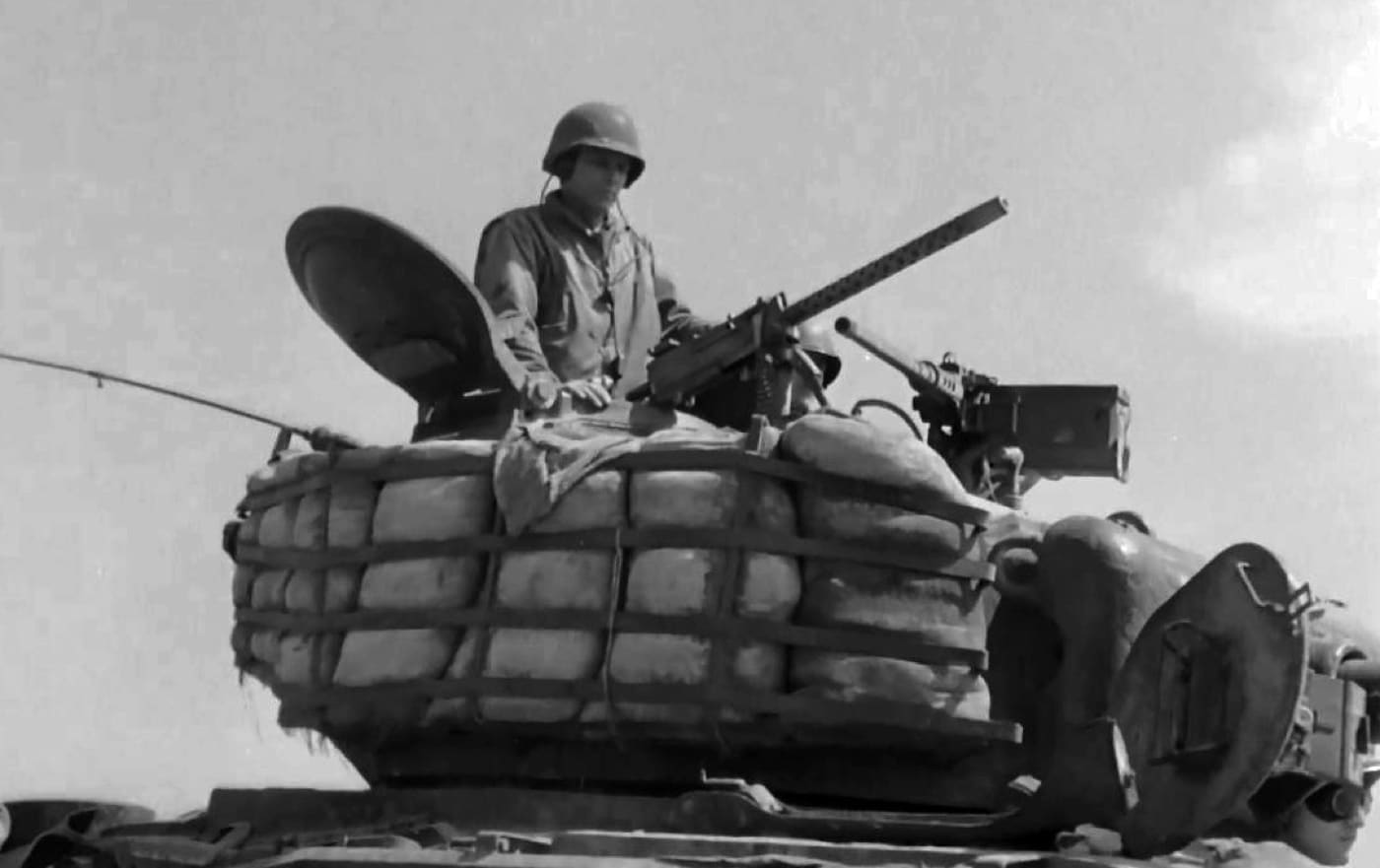
In the spring of 1945, American tank-infantry tactics progressed by leaps and bounds. The G.I.s advancing ahead of their armored support identified and suppressed German AT guns and tank-hunter teams.
On board the Sherman tanks, many vehicles had their Browning M2 .50-cal. AA MG relocated to a position forward of the commander’s hatch, and a Browning M1919A4 .30-cal. MG mounted in front of the loader’s hatch. This combined firepower helped eliminate Panzerfaust gunners who presented a prime target as they maneuvered for a shot.
War Department Observer’s Report
In the spring of 1945, War Department Observer Colonel George W. Coolidge spent time with American armored units fighting in Germany. The following is his complete report, titled “Defense against anti-tank weapons”, issued on March 2, 1945:
1. During the visit of the undersigned with armored elements of Seventh Army, I was impressed with the activity being shown in attempts to counteract German anti-tank weapons. Of primary importance of course were those measures taken trying to defeat German anti-tank guns and bazookas, for which all armored personnel have considerable respect.
2. Of particular interest was the sandbagging of tanks as practiced by the 14th Armored Division. The installations were being accomplished by the maintenance battalion of the division. They consisted mainly of shelves and brackets welded to the front plate, sponsons and turret to hold the bags in place. Standard engineer sandbags were utilized, two deep on the sides of the sponsons and turret and two to four deep on the front plate.
3. Results for these sandbags were as follows:
A) One M4 medium tank with sandbags was hit by a German high velocity 75mm on the front plate in front of the driver. Only partial penetration was obtained and the driver was uninjured. Unfortunately, this first round knocked off the sandbags and a second round struck the unprotected plate to the left of the driver, disabling the tank.
B) Commanding officers of both the 25th and 48th Tank Battalions stated they had authentic cases where the sandbags had stopped the German bazooka, both the Panzerfaust and the standard 88mm bazooka. It was stated that the bags had saved at least eight tanks of the division from bazooka fire.
C) From interviews with tank commanders and crew members, I gathered that if the bags did nothing more, they were certainly a morale factor as the crews were thoroughly impressed with them.
D) No marked decrease in performance of the tank was reported, though considerable weight was obviously added. In this connection, the division ordnance officer estimated about one ton was added, however, unit commanders estimated that the additional weight was closer to three tons. My personal belief is that the latter estimate is more nearly correct.
E) One deficiency of the installation was that in the case of the bags on the turret, sand had a tendency to leak down into the turret race and bearings. A metal shield under the bags was to be added to correct this.
4. The 12th Armored Division were divided in their opinions as to the value of the sandbags, however a number of units were taking steps to provide them. The 23rd Tank Battalion, with the view to providing something more permanent, was experimenting with applying concrete to the front deck and sponsons. Of the vehicles so modified, the following procedure was utilized:
A) 3/4 inch bolts, 6 1/2 inches long, were spot welded perpendicular to the surface of the armor at about 12-inch intervals. Two layers of heavy wire mesh were then welded to the bolts, with the mesh being placed parallel to the surface of the armor–the first layer 2 inches from the surface and the second layer 4 inches. Lengths of reinforcing rods were then welded to the ends of the bolts forming, in reality, a third layer of mesh. Wooden forms were then used to hold the concrete pour — an 8-to-1 mixture of concrete being utilized.
B) No test firing had been conducted, no combat experience demonstrated the efficiency of this reinforced concrete in defeating bazooka or anti-tank fire. The Seventh Army Ordnance Officer indicated that from data available the concrete would actually prove less effective than sandbags in defeating high-velocity projectiles.
5. The armored section of the 7th Army informed the undersigned that all M5A1 light tanks were having their belly armor reinforced. This modification was being effected due to the failure of the weld along the forward edge when the tank hit a mine. It was reported that several bow gunners and drivers lost their legs when their light tanks hit a mine. It was stated that unless this deficiency had not already been corrected in the M24 light tank, a similar modification would have to be made.
George W. Coolidge Colonel, Cavalry
War Department Observers Board
Sandbags on the M24 Chaffee
American light tanks were also given an application of sandbags — the earlier M5 Stuart tank, and the M24 Chaffee that appeared in 1945.
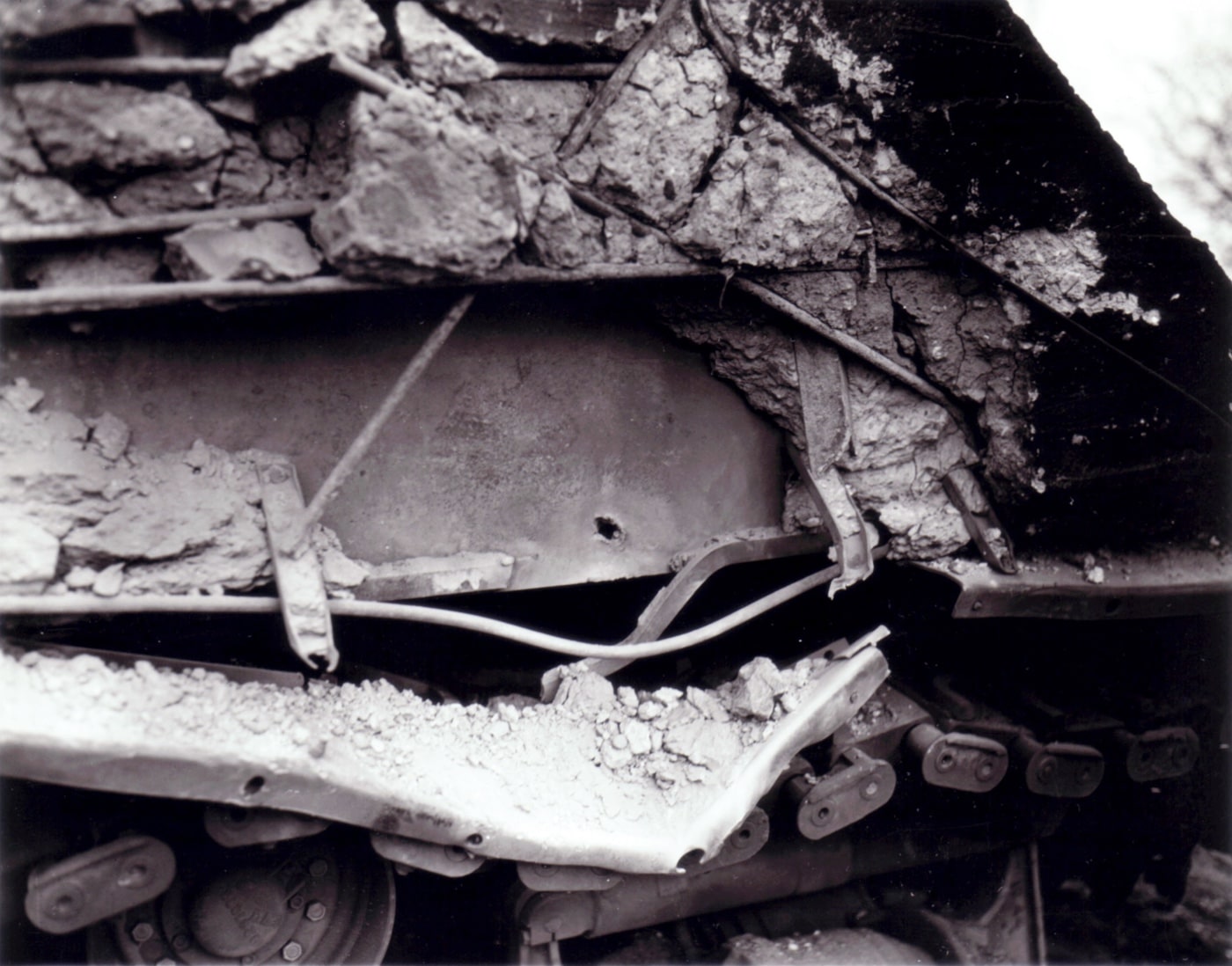
The following excerpts come from a report on the M24 Chaffee light tank provided by the 744th Light Tank Battalion in April 1945:
It has been standard practice to sandbag the front slope plates of the tanks, and it is believed that such has afforded additional protection for the tank, especially from Panzerfausts and rifle grenades. The extra weight has caused no appreciable difference in the performance of the tank. The extra weight in armor plate, rather than sandbags, would no doubt offer more protection, and is therefore recommended.
An Effective Expedient?
The last year of World War II saw the German deploy some highly effective infantry anti-tank weapons. The later variants of the Panzerfaust were particularly deadly, and there was no Allied tank that could resist their powerful shaped-charge warhead. In that light, the expedient sandbag, concrete, and composite protection added to American Sherman tanks gave them a better chance of survival in a multiple threat environment.
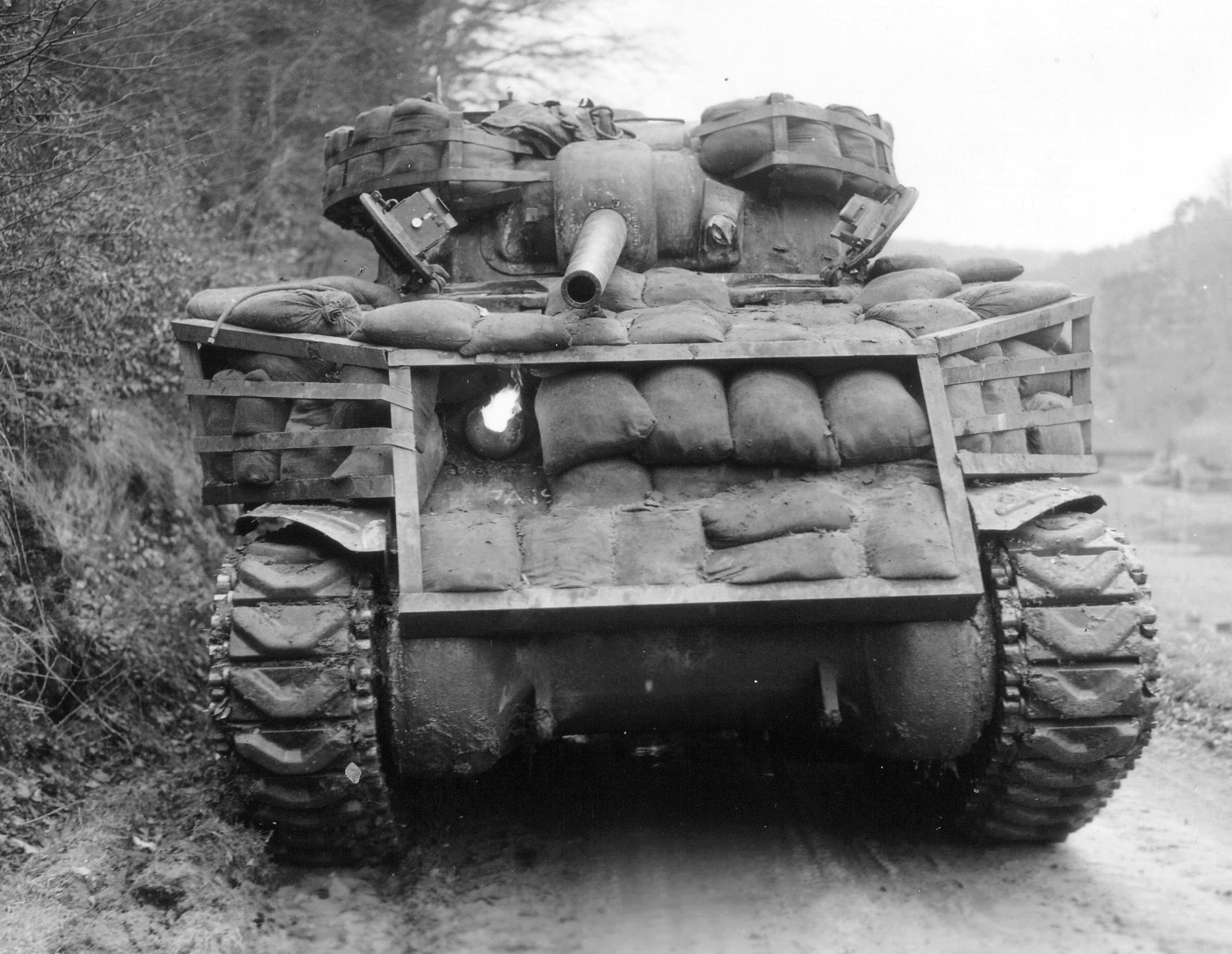
The Panzerfaust was deadly, but also inaccurate — its bulbous warhead wobbled to the target and its unreliable impact fuse needed a solid hit to maximize its tank-killing effect. Sandbags saved many M4s from taking a direct hit.
Also, the issue of bolstering crew morale cannot be understated. U.S. tank crews understood that there was no magical addition that would make their Sherman tanks impenetrable. But, the ability to add protection and increase crew survivability via their own ingenuity, even if it was only a marginal improvement, went a long way to preserving their fighting spirit. American tank crews had to walk a fine line between aggressiveness and recklessness, and the winning momentum of U.S. armored divisions could not abide tentative maneuvers.
Sadly, losses in both men and machines had to be taken, but the Shermans still rolled on despite the German defenses. Ultimately, sandbags did not win the tank war, but they were an important component in the final victory.
Editor’s Note: Please be sure to check out The Armory Life Forum, where you can comment about our daily articles, as well as just talk guns and gear. Click the “Go To Forum Thread” link below to jump in and discuss this article and much more!
Join the Discussion
Read the full article here

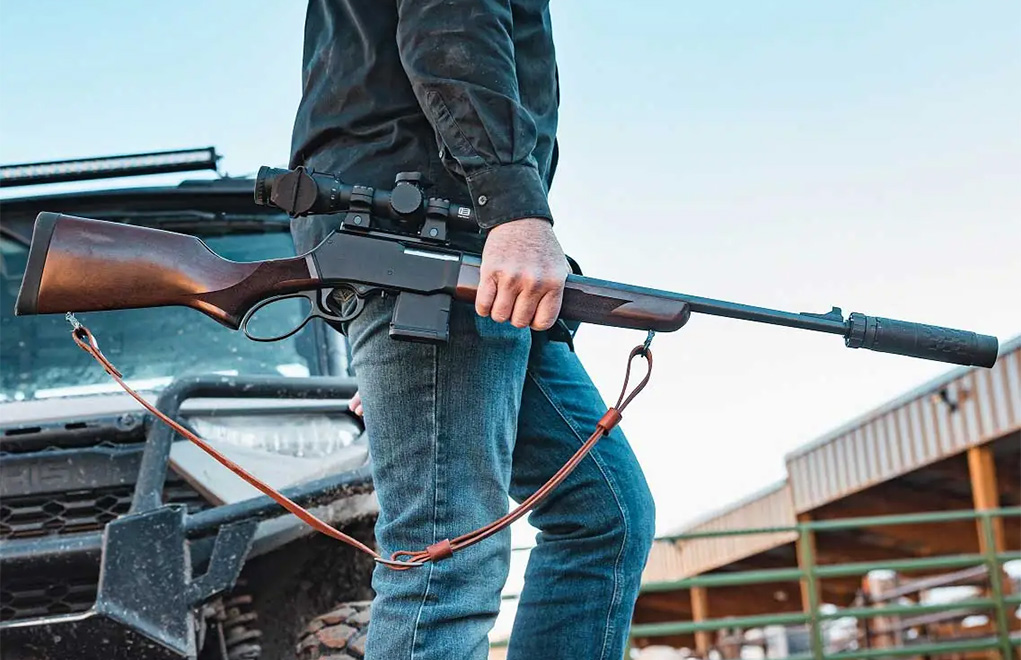

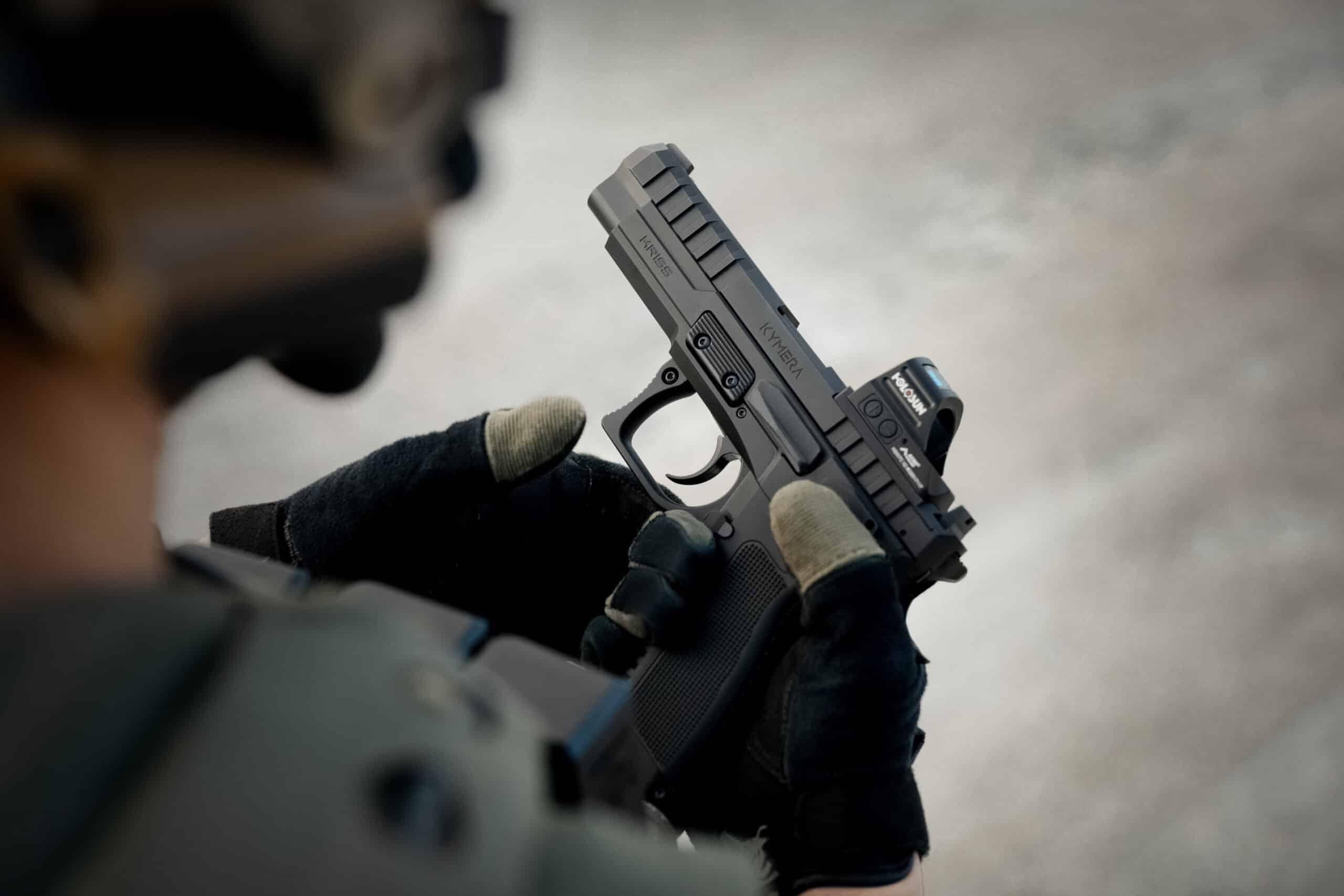

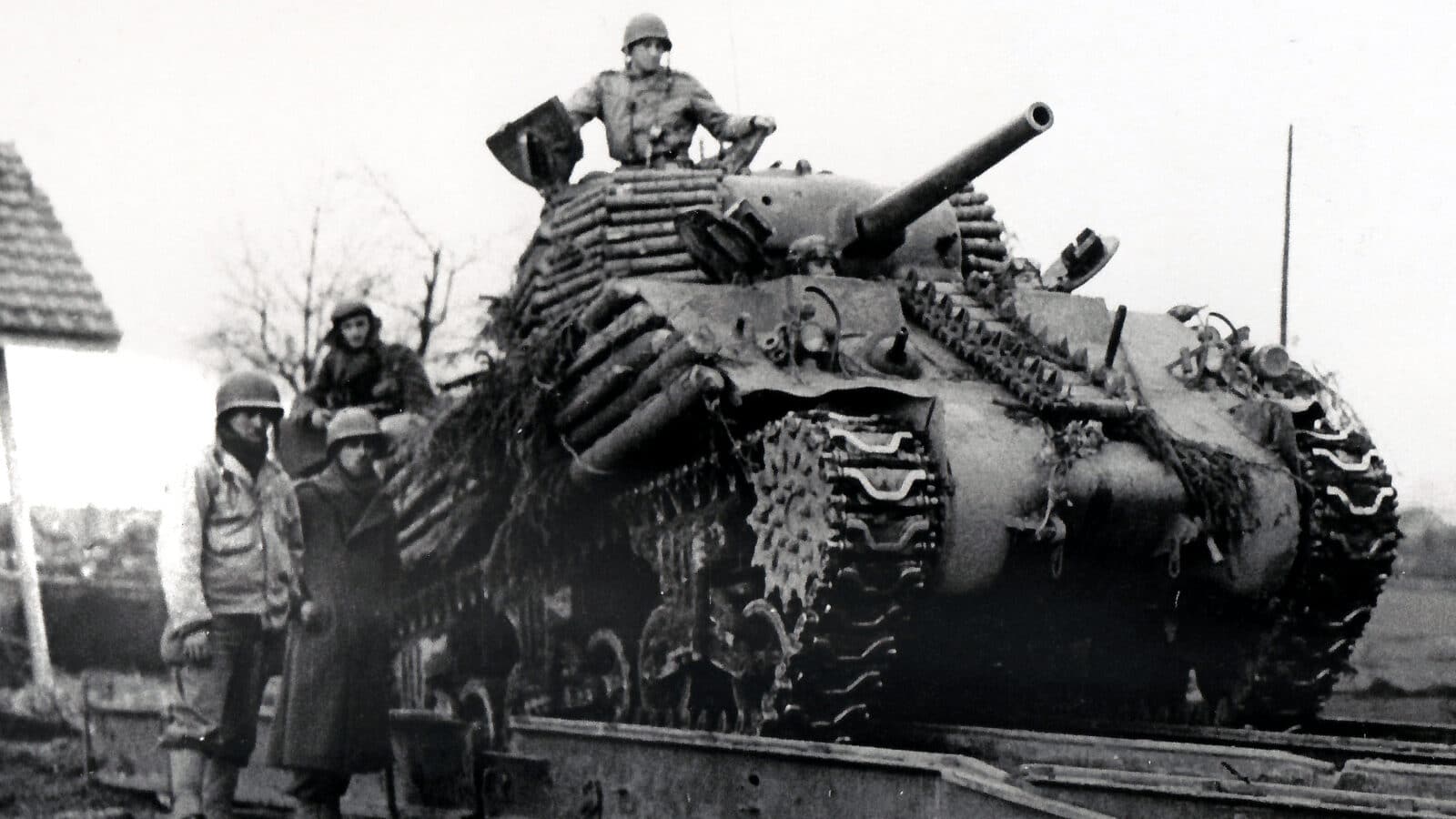
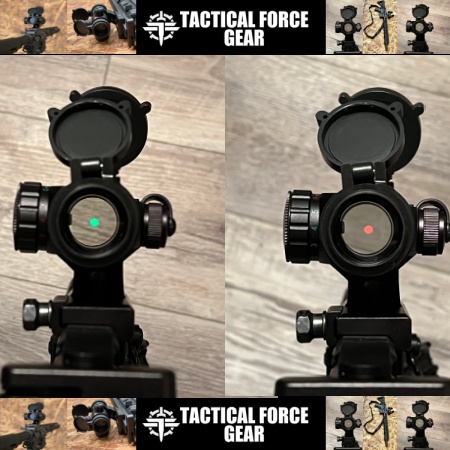






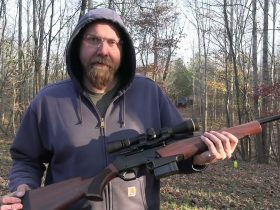
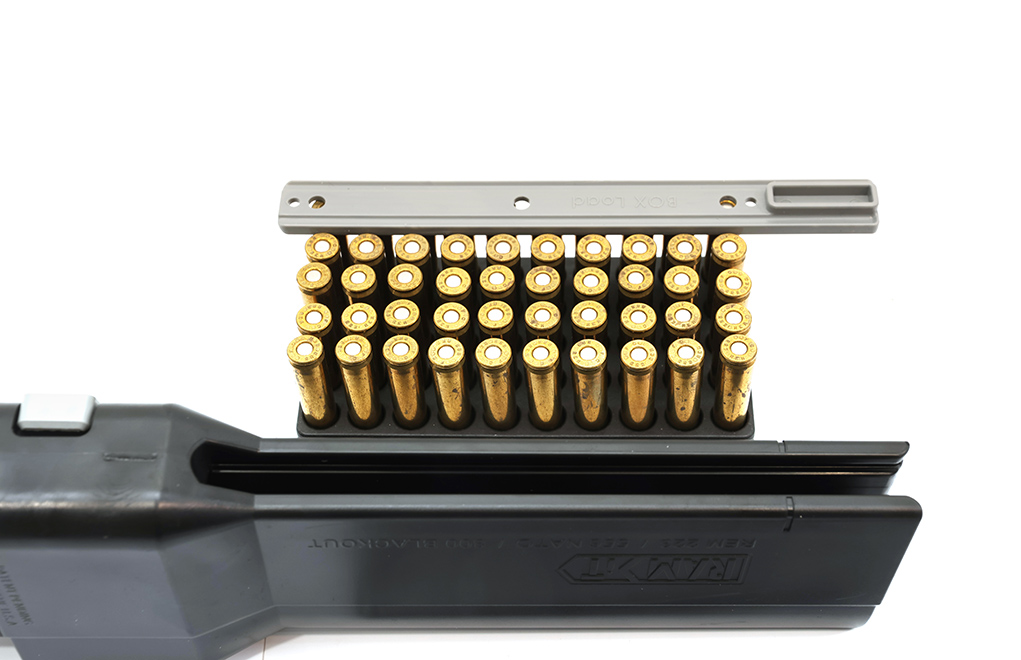
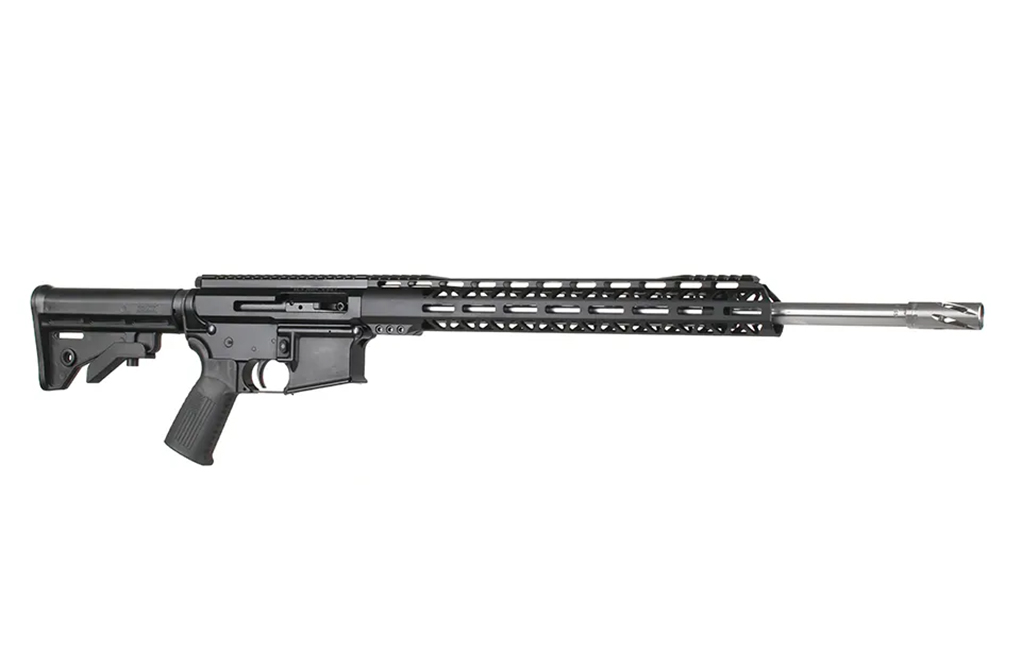
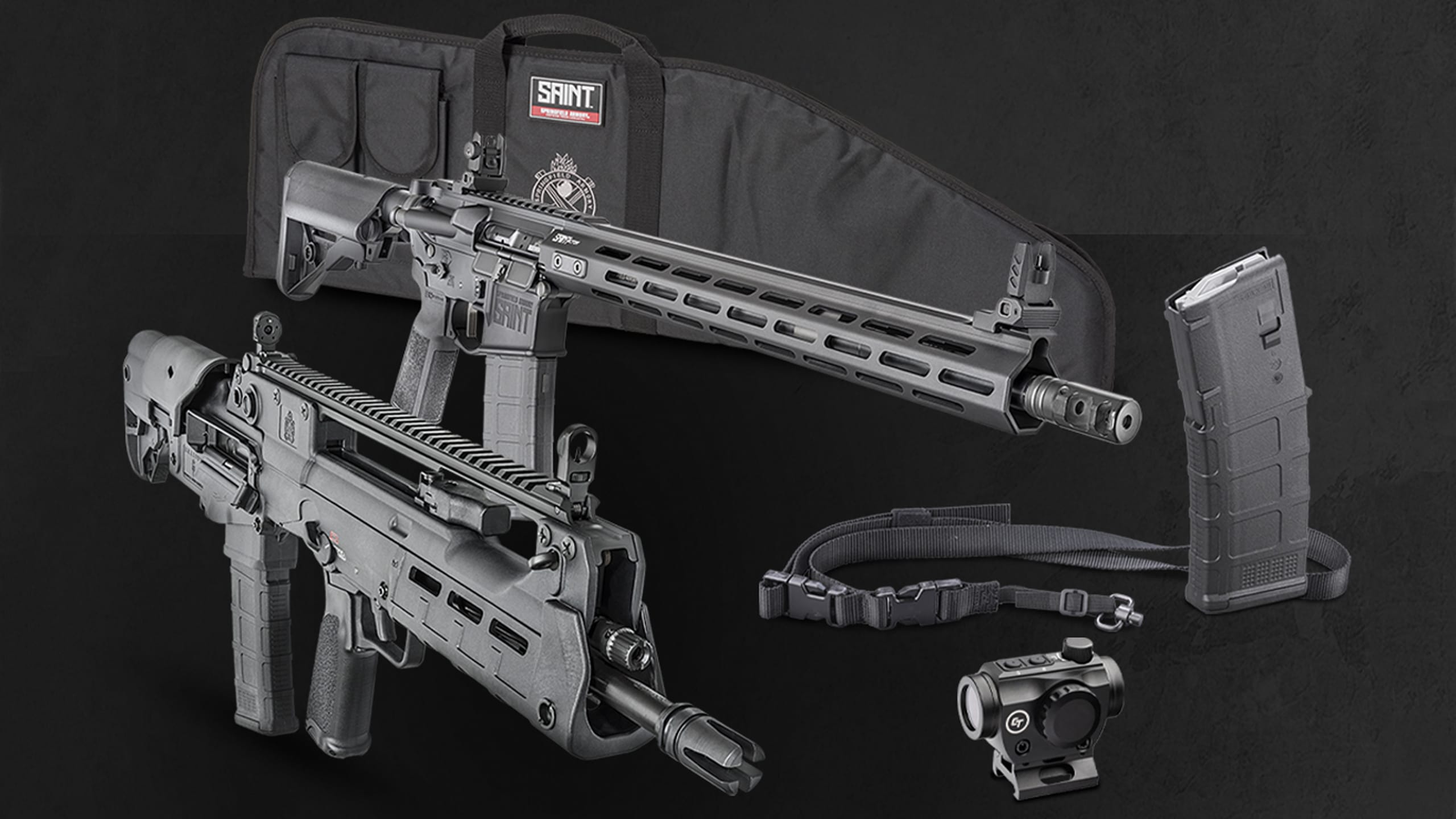

Leave a Reply